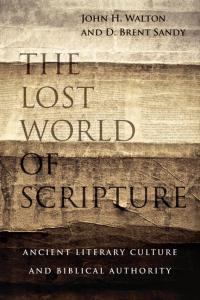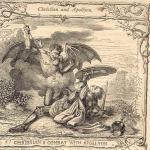 The next chapter of The Lost World of Scripture by John Walton and Brent Sandy summarizes their main points thus far. The Bible as we have it emerged out of an oral culture and reflects the values and expectations of that culture. God revealed himself to his people in that culture and the stories and events were passed along through generations (Old Testament) or decades (New Testament) before being written down. There are some exceptions. The letters of Paul were written to churches. Revelation and a few books of the Old Testament (perhaps Ezekiel?) were produced in written form. And there are some written sources used in producing the books of the Bible – the annals of the Kings of Judah and Israel for example (see 1 and 2 Kings).
The next chapter of The Lost World of Scripture by John Walton and Brent Sandy summarizes their main points thus far. The Bible as we have it emerged out of an oral culture and reflects the values and expectations of that culture. God revealed himself to his people in that culture and the stories and events were passed along through generations (Old Testament) or decades (New Testament) before being written down. There are some exceptions. The letters of Paul were written to churches. Revelation and a few books of the Old Testament (perhaps Ezekiel?) were produced in written form. And there are some written sources used in producing the books of the Bible – the annals of the Kings of Judah and Israel for example (see 1 and 2 Kings).
The Bible we have shows many remnants of the oral culture in which it originated.
Variations are inevitable and don’t raise eyebrows. Nor do the undermine the veracity of the message. We fret the details – but the original audience didn’t.
Speeches represent the intent of the speaker, but are not expected to be literal transcriptions. “Ancient historians recognized that variations were unavoidable when drawing from oral sources, and without scripts of speeches they reconstructed what speakers likely said, though the style of the author shows through in the speeches.” (p. 185) Consider the speeches of Moses in the Pentateuch (Exodus to Deuteronomy). “Summarizing briefly, some of the sermons and other oral pronouncements of Moses were likely written during his lifetime and under his supervision, though others may have been produced by later generations following various stages of oral transmission.” (p. 193) And all of these, from whatever source (oral or written) were collected and translated into the Hebrew text.
Jesus and his followers were completely comfortable with the oral culture. “Authority did not begin in written text.” (p. 186) Spoken words and messages passed along by Jesus and his followers carried the authority of God’s message.
“Exact wording was rarely possible and usually unnecessary to represent truth reliably.” … “The variants that appear among the Gospels are witness to the flexibility of the transmission process. The essence was preserved, although precise wording and fixed details may not have been.” (p. 186)
Translation is interpretation – something that was taken for granted in the ancient oral culture. The Septuagint interprets the Hebrew text, sometimes introducing slightly different ideas. Occasionally details from a later time may appear in the new telling of a story – perhaps domesticated camels in Genesis and some place names etc. represent later variations – the oral text preserved meaning but not exact wording or detail. (John and Brent don’t bring up the issue of camels – but it is one that has been raised by commenters and readers here before.)
The Dead Sea Scrolls show signs of the acceptance of variants and even “insertions, deletions, rearrangement and paraphrasing.” John and Brent quote Bruce Waltke (How We Got the Hebrew Bible in The Bible at Qumran). “The presence of such a variety of text types at a single location … suggests that members of that community … do not seem to have been particularly troubled by discrepancies in biblical manuscripts.” (p. 190)
The use of the Old Testament in the New Testament also demonstrates a comfort level with variation and interpretation. Quotes are paraphrases, occasionally they are misattributed (Mk 1:2, Jn 10:34). Passages are adapted to make a point, or imperfectly recalled from memory – Paul, in particular, did this.
John and Brent conclude:
As noted above, if we fail to appreciate ancient communicative processes and do not make room for the uniqueness of oral culture, them we put our understanding of ancient texts in jeopardy. This applies in particular to the implications of orality for doctrines of Scripture. The inerrancy view affirms that Scripture is free from error in all respects. But with the evidence for frequency of variants and differences in detail noted throughout this book – either because of oral transmission or scribal alteration – one could argue that there are a variety of errors in the written texts of Scripture. But by what standard? If modern print culture provides the criteria, then yes, we would have to admit there are errors. But is that nor overlooking the distinctiveness of oral culture?
…
To say there are errors in the Bible is to read Scripture anachronistically. Conversely, those who say that there are not errors need to make clear that they are representing an ancient view of reliable representations of truth. Modern print culture simply must not be the standard by which the practices of ancient composition and transmission are judged. (p. 195-196)
And an important closer:
Common definitions of inerrancy do not fit scenarios understood in light of orality (though some responsible constructive theological accounts come close). Yet orality was the way God chose, which must mean it was the right way. Evidently we need to adjust our understanding of inerrancy to the evidence we find in Scripture. (p. 196, emphasis added)
Personally I find the term “inerrancy” of little value. Scripture is inspired by God and reliably reveals and transmits his Word to us. I read and study it for this message – not to separate truth from “error” or to squeeze it into the mold of our 20th/21st century expectation. We have to let Scripture itself be our guide as to appropriate modes and genres for preserving the message.
John and Brent emphasize the oral culture as distinct from our modern text based culture and the implications this has for the ways that truth is accurately conveyed. At times they seem to over emphasize orality – but the overall thesis is important as are the conclusions.
Aside from some outliers, Christians have always been comfortable with the spoken word and sermon as well as with translation and interpretation. Every translation is an interpretation and all we have is translations for much of Scripture. Every sermon and Scripture reading carries an element of performance. The message is reliably transmitted in these modes. The Bible retains ample evidence to its ancient and oral origins and transmission. We need to be comfortable with Scripture as we have it, not as we would have done it if we were in charge.
More to come in part 3 of the The Lost World of Scripture.
If you wish to contact me directly you may do so at rjs4mail[at]att.net
If interested you can subscribe to a full text feed of my posts at Musings on Science and Theology.















